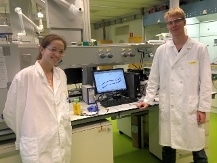Jun 14 2017
Nitrogen-doped carbons are new materials that have promising applications in fast energy storage, for example, for fast charging of cellphones or regenerative breaking. The specific capacitance of these carbons has been tripled by Students at the University of Amsterdam's Research Priority Area Sustainable Chemistry.
 Sustainable chemistry students Ilse Denekamp and Jasper Biemolt. Photo: HIMS.
Sustainable chemistry students Ilse Denekamp and Jasper Biemolt. Photo: HIMS.
The Students examined the factors that govern a wide range of supercapacitance modes in the new supercapacitor material that was invented at the University of Amsterdam (UvA). They succeeded in tuning the materials' surface structure and functional groups to maximize speedy faradaic reactions at the surface, storing energy in transient chemical bonds. The findings feature in ChemSusChem, a high-impact international journal.
Fast charge/discharge cycles
Efficient energy storage solutions are required for the transition to sustainable energy sources. Each renewable energy source, be it geothermal, solar or wind, sets its own requirements for power density, energy density, size, cost and life-time. Supercapacitors, also known as ultra-capacitors or electrochemical capacitors, are considered to be vital power sources for applications needing fast discharge/charge cycles.
Recently, Dr David Eisenberg and Prof. Gadi Rothenberg, of the Van 't Hoff Institute for Molecular Sciences, invented a new type of supercapacitor material produced from hierarchically porous nitrogen-doped carbon.
Sustainable Chemistry Students Jasper Biemolt and Ilse Denekamp, in order to progress on that invention, began investigating in their MSc project the factors that govern the storage of energy at the surfaces of these materials. They discovered the possibility of customizing the number and type of nitrogen functionalities at the surface by tuning the synthesis conditions, thus improving the capacitance nearly threefold.
3D printed 'minion'
The measurements needed a dedicated setup, developed from isolating materials to high specifications of structural constraints and mechanical pressure. The device was designed and printed on a 3D printer using high-density polystyrene by PhD Student Thierry Slot. The device, called The Minion" due to its green and yellow colors, enabled measurement of the capacitance of the new materials.
The Amsterdam team included the CAD files in order to enable Researchers who desire to repeat the experiments for 3D-printing their own equipment. Rothenberg predicts that an increased number of Researchers will incorporate such files as supporting information with scientific papers.
We are just starting to realize the potential of 3D printing for the design and printing of tailored-to-purpose lab equipment. As 3D printing becomes more accessible and more types of materials can be printed, designing of equipment for specific experiments will also become easier, and by publishing the CAD files researchers across the globe will be able to print the same equipment in their own labs.
Prof. Gadi Rothenberg, the Van 't Hoff Institute for Molecular Sciences